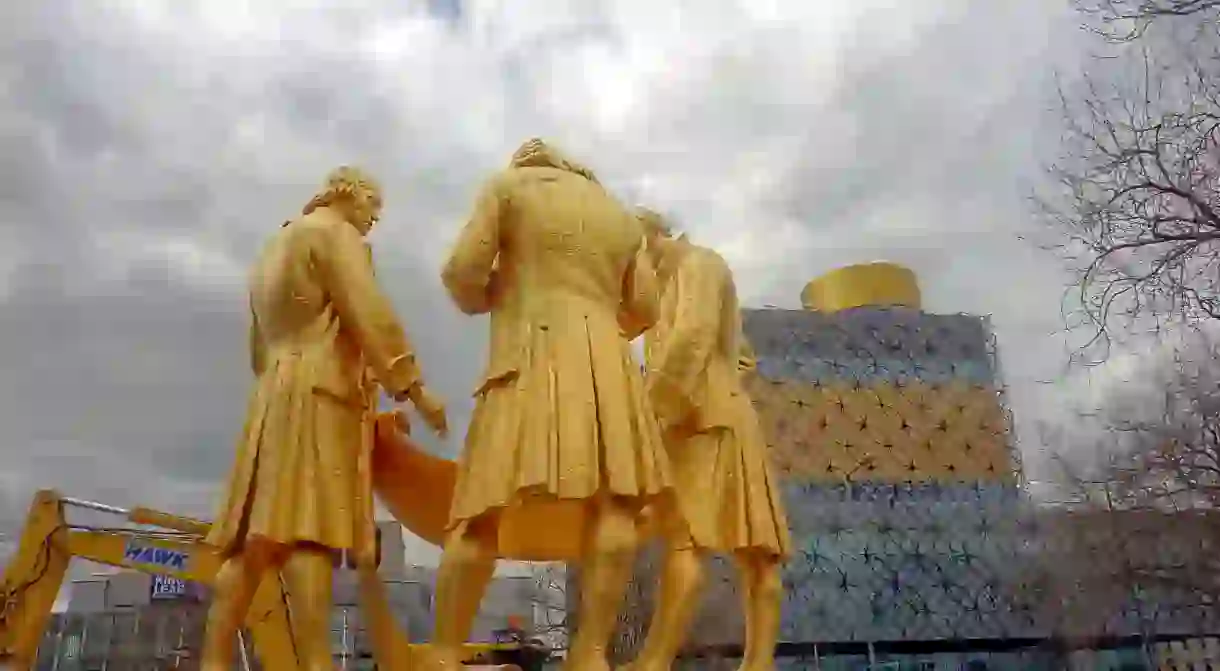A Tour of Birmingham’s Statues and Sculptures

Take a quick walk around Birmingham city centre and you’ll undoubtedly see some of the wonderful public art on offer. Below we give insight into five of the most popular statues and sculptures in the centre of Brum.
The Guardian (widely known as The Bull)
Possibly the work of public art synonymous with Birmingham, the six-tonne bronze bull – officially known as The Guardian – can be found outside the Bullring shopping centre. Sculpted by Laurence Broderick and unveiled in 2003 to a crowd of more than 270,000 people, the magnificent bronze bull was recently voted one of the top ten works of public art in the world by The Independent. The Bull comes in at number eight on a list which features the Statue of Liberty and Michelangelo’s David.
The 2.2-metre tall statue mimics a Hereford bull – which has strong historical relevance to the city – turning in motion, and heralds Birmingham’s history, regeneration and forward-thinking attitude. The Bull is a popular tourist attraction, often used as a meeting point by locals, and comically dons different outfits at seasonal periods.

Boulton, Watt & Murdoch
Nicknamed ‘The Carpet Salesmen’, William Bloye’s sculpture of Matthew Boulton, James Watt and William Murdoch can be found on Broad Street, outside the House of Sport (formerly the Register Office). The statue of the three Industrial Revolution pioneers was unveiled in 1956, following preliminary plans that had been drawn up as early as 1938. The three figures are set in bronze with a gold finish and stand above a large pedestal of Portland Stone.
Boulton, Watt and Murdoch were highly influential in late-18th century England for their work surrounding manufacturing, the steam engine and gas lighting respectively. All three men are buried in the city at St Mary’s Church, Handsworth.

Queen Victoria
Thomas Brock’s marble statue of Queen Victoria stands proud in Victoria Square and was unveiled on January 10, 1901 – just 12 days before her death. In 1951, the statue was recast in bronze to mark the Festival of Britain by local sculptor William Bloye, who was responsible for a number of statues in Birmingham, including Aston Hall’s statue of the Greek god, Pan. During the renovation of Victoria Square in 1992, the statue was temporarily removed for cleaning but returned in 1993 upon completion. There is a plaque nearby the statue in memory of Ebony; the black Labrador who accompanied a workman on the restoration of the square by carrying his tools. The plaque reads ‘On site: Ebony 1992-1993’ with the dog’s paw print.

Iron: Man
Just a stone’s throw from the statue of Queen Victoria is Anthony Gormley’s Iron: Man, a statue which represents the skills that Birmingham and the Black Country practiced during the Industrial Revolution. The statue, a gift to the city from the Trustee Savings Bank, was erected in 1993 outside Victoria Square House, their former headquarters. Originally named Untitled, the statue gained the nickname ‘Iron: Man’ and the name officially stuck. Standing tall at 20 feet (6 metres), the piece also shares its name with a song by Birmingham’s very own heavy metal pioneers, Black Sabbath.

Tony Hancock
Critically acclaimed comedian Tony Hancock was born in Hall Green, Birmingham on May 12, 1924. Though his family moved to Bournemouth in his early years, Hancock will be fondly remembered as being Brummie-born.
A statue of the ’50s and ’60s comic was unveiled in 1996 by Sir Harry Secombe – aptly on the former site of the Birmingham Blood Transfusion Service – in remembrance of ‘The Blood Donor’, a popular episode from his BBC comedy series Hancock. The statue depicts one of the most iconic images of Tony Hancock and has since been moved to the centre of Old Square.














